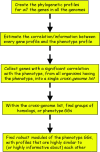Ab initio genotype-phenotype association reveals intrinsic modularity in genetic networks
- PMID: 16732191
- PMCID: PMC1681479
- DOI: 10.1038/msb4100047
Ab initio genotype-phenotype association reveals intrinsic modularity in genetic networks
Abstract
Microbial species express an astonishing diversity of phenotypic traits, behaviors, and metabolic capacities. However, our molecular understanding of these phenotypes is based almost entirely on studies in a handful of model organisms that together represent only a small fraction of this phenotypic diversity. Furthermore, many microbial species are not amenable to traditional laboratory analysis because of their exotic lifestyles and/or lack of suitable molecular genetic techniques. As an adjunct to experimental analysis, we have developed a computational information-theoretic framework that produces high-confidence gene-phenotype predictions using cross-species distributions of genes and phenotypes across 202 fully sequenced archaea and eubacteria. In addition to identifying the genetic basis of complex traits, our approach reveals the organization of these genes into generic preferentially co-inherited modules, many of which correspond directly to known enzymatic pathways, molecular complexes, signaling pathways, and molecular machines.
Figures







References
-
- Alberts B, Bray D, Lewis J, Raff M, Roberts K, Watson J (1994) Molecular Biology of the Cell. New York: Garland Science Publishing
-
- Altschul SF, Gish W, Miller W, Myers EW, Lipman DJ (1990) Basic local alignment search tool. J Mol Biol 215: 403–410 - PubMed
-
- Berardi MJ, Bushweller JH (1999) Binding specificity and mechanistic insight into glutaredoxin-catalyzed protein disulfide reduction. J Mol Biol 292: 151–161 - PubMed
-
- Collazo CM, Galan JE (1997) The invasion-associated type III system of Salmonella typhimurium directs the translocation of Sip proteins into the host cell. Mol Microbiol 24: 747–756 - PubMed
Publication types
MeSH terms
Grants and funding
LinkOut - more resources
Full Text Sources
Research Materials

